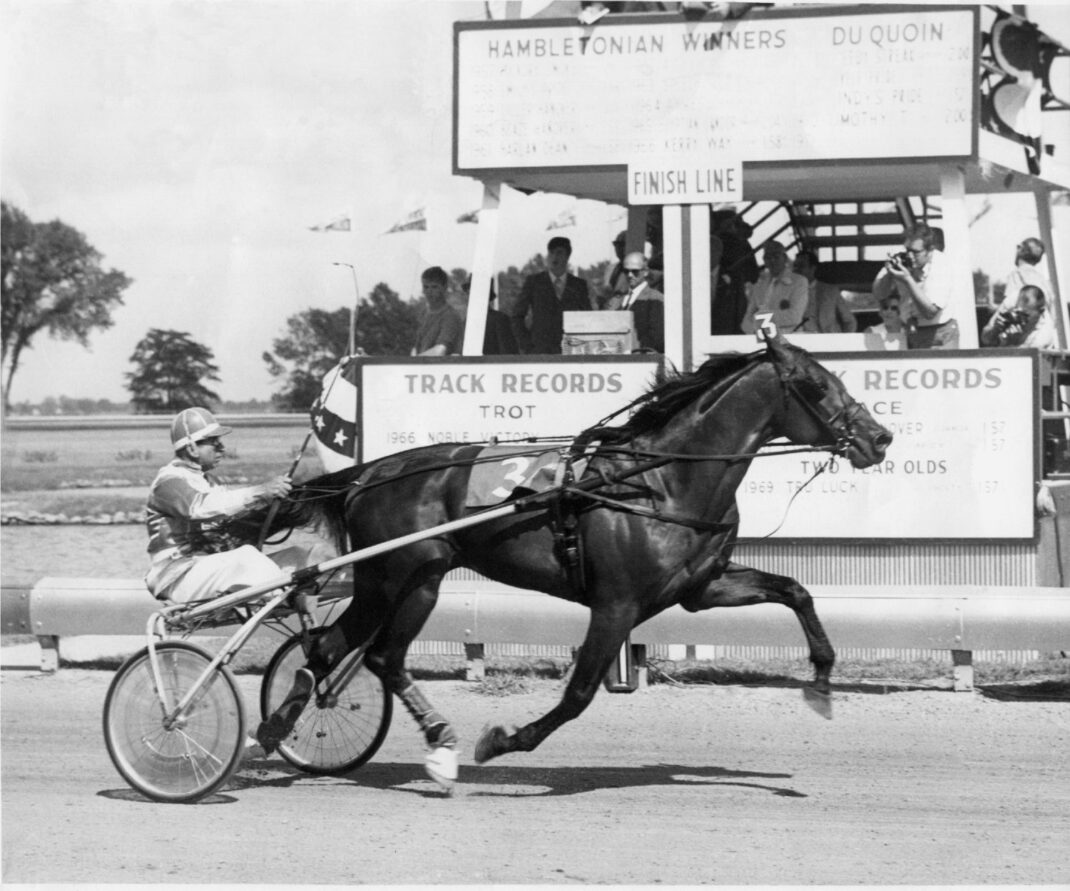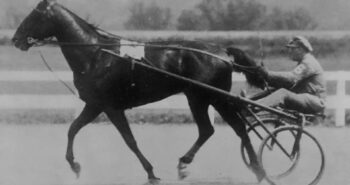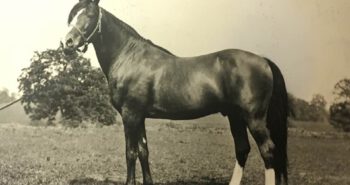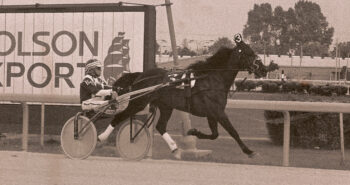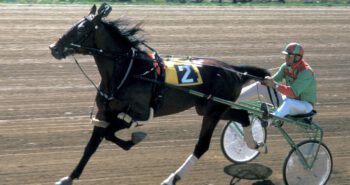From humble beginnings, he became one of the best three-year-olds, then went on to dominate as an aged trotter. In was at stud he established himself as one of the true legends of trotting, though, but it was a stroke of luck that Speedy Crown wasn’t lost to American trotting after his two-year-old season.
Speedy Crown was bred by Ann W Beissinger, wife of Howard Beissinger. The couple’s part in the story starts back in 1955, when Howard bought filly Worth a Plenty at yearling auction. A daughter of Darnley and Sparkle Plenty, she had a good sire with a relatively modest maternal family. Her great grandam, Ellie Trabue, finished third in the inaugural Hambletonian in 1926, and produced p2:02 (1.15,8) pacer My Son, but there was otherwise very little discernable quality in the maternal family. Worth a Plenty’s sire Darnley was a promising sire who had produced Jamie, winner of the American Trotting Championship in 1955, Hit Song, who after two really good seasons in the US, topped by second place in the 1952 Hambletonian, had gone on to racing fame in Italy plus Darn Safe, winner of the 1954 American-National and third in the Kentucky Futurity. Later, Worth a Plenty’s full brother City Light became another good export to Italy, topped by his third-place finish in the 1967 Prix d’Amerique.
Worth A Plenty was an average trotter who raced to a 2:02.2 (1.16,1) record in a time trial at 3, before going lame. Her first foal was 1961 filly First Dividend by Triple Crown-winner Scott frost. Beissinger had gotten a free breeding to Florican from Castleton Farm in Kentucky and used this in 1961. The following spring the mare delivered a filly who was named Missile Toe. Beissinger was training privately in the mid-1960s and could not train his own filly. He assigned her to John Hague, and Missile Toe raced primarily at fairs in Ohio where she more than held her own. She time trialed in 2:05.2 (1.17,9) at 3.
Missile Toe, as many of the Floricans, didn’t have much knee action in front. On the opposite side of this spectrum was Speedy Scot, who Beissinger bred his mare to in early 1967. On Jan 29, 1968, a bay colt was born. According to Dean Hoffman’s article Looking Back at Speedy Crown, Beissinger had just returned from seeing his first National Finals Rodeo at the time, and named the colt Headin And Healin, after an rodeo event officially called team roping.
A slow start
In March 1970, the Beissingers sold the two-year-old to Thomas and Frank Antonacci’s Crown Stable. Beissinger continued to train and drive him, but the name was changed to Speedy Crown. There was nothing to indicate the horse was a future superstar, then, but Beissinger never pushed the colt and deliberately matched him cautiously at 2.
“Speedy Crown was very sound at two. The only thing we did was in the spring of that year I had a splint removed. He was a nice-sized horse, but not overly big,” Beissinger told Hoffman for his article.
The Speedy Scot son was ready early, though, and made his career debut on The Meadows on July 30, 1970, but ended in the back of the field won by Dark Valley in 2:12.1 (1.22,2). Speedy Crown quickly put it together, and Dark Valley stood no chance when the former, driven by Mike Zeller, won in 2:08.1 (1.19,7) on the same track on Aug 27. After four straight wins, Beissinger decided to give the two-year-old a challenge and started him against older horses in the Three Rivers Trot at The Meadows on Sep 11. Drawing the outside post, Speedy Crown put in a good performance, but lost to favorite Tarport Devlin who won in 2:07.1 (1.19,1). Going to Lexington, the colt was then started in the Transylvania Trot but ended outside the money as Quick Pride won in 2:02.4 (1.16,3) ahead of Savoir and Landsdowne. Speedy Crown time trialed in 2:01.2 (1.15,5) shortly after.
Overall, Speedy Crown finished the year with four wins in eight starts, a record of 2:08.1 and earnings of $2,025. Still, nobody expected the colt to rise to the top the following season. In the experimental ratings, Noble Gesture, with eight wins in ten starts, was listed first with a time of 1:57. Behind him followed Quick Pride, the 2-year-old trotter of the year in 1970, and A.C’s Orion. Speedy Crown was a measly 23 on the list. He would soon prove that to be a terrible miscalculation of judgment.
Almost became Swedish
At that point, Speedy Crown could have been on his way to Europe. Swedish trainer Roy Berglöf and his son Erik – who later gained fame as the trainer of Copiad – were looking to buy a two-year-old. They were offered Net Profit and Speedy Crown, the latter at $60,000. Berglöf recalls they looked at both colt’s careers and noticed that Net Profit had finished the year stronger, thus picking that one. “We chose Net Profit and it wasn’t a bad buy since it was a good horse, but sometimes I wonder what Swedish trotting and my own career as a trainer would have looked like if we had bought Speedy Crown”, he later said in an interview with the Scandinavian Trotting Museum.
In Net Profit, by Dartmouth, the Swedish buyer got some of the same bloodlines, though. The colt’s dam First Dividend, by Scott Frost, is a sister to Speedy Crown’s dam Missile Toe, by Florican.
Domination
Over the winter the colt improved dramatically and at 3, the son of Speedy Scot was dominant. It started out in small races, though. On May 24, 1971, Speedy Crown made his seasonal debut in a race for non-winners of $3,000 lifetime and won comfortably in 2:05 (1.17,7). A week later he was back at the half-mile track and made it two in two for the season after another easy win. An AP article started that “odds-on favorite Speedy Crown lagged behind, finally took the lead at the post on the outside, lost it in the stretch, then poured it on to win by 3 1/2 lengths.” In the next race, he lead from gate to finish, winning ahead of Painted Doll and Another Love in 2:02.4 (1.16,3). As a curiosity, Speedy Crown was later bred to Another Love and produced Astro Hill, fourth in the 1983 Hambletonian.
After three wins in a row, newspapers started mentioning the colt as a Hambletonian hopeful. It was time to meet the best again, and on Jun 19 he met up with Quick Pride and nine others in the American-National at Sportsman’s Park in Chicago. The Chicago Tribune wrote that “Quick Pride and Speedy Crown battled for the lead shortly after the start, but Quick Pride took command at the first quarter and remained in front until overtaken by Speedy Crown in the final yards. Speedy Crown dropped to third as the field reached the halfway mark of the mile test, but regained second place and was only half a length behind Quick Pride at the top of the stretch. The two horses then engaged in their close tussle to the finish line. (…) Quick Pride, directed by Stanley Dancer, tried valiantly to stave off the challenge of Speedy Crown, but the winner possessed tremendous speed in the final eighth of a mile.” Just five days later he took his fifth straight win by capturing the Challenge Stakes at Scioto in 2:01.3 (1.15,6).
He wasn’t eligible to the Yonkers Trot, won by Quick Pride. Beissinger instead opted to start at Scioto and Speedy Crown took another easy win. Going to Vernons Down on Jul 23, Speedy Crown easily held off Top Freight and Hoot Speed to win in 1:59.4 (1.14,4), breaking the 2:00 barrier for the first time. He improved on that in the first heat of the Founders Golf Cup at Vernon one week later, winning in 1:59.3 (1.14,3) ahead of Keystone Hilliard and Hoot Speed. However, in his next race the three-year-old showed he was beatable when he found traffic problems and couldn’t get clear as he was trapped on the rail with no racing room. Keystone Hilliard won in 2:00. On Aug 11, he lost his second race in a row when he finished second to Hoot Speed in the Arden Downs Stake at The Meadows. In that race Hoot Speed led wire to wire in 2:01 (1.15,2) while Speedy Crown raced on the outside the entire race, in the end losing by 3/4 length.
The two final races for the 3-year-olds prior to the Hambletonian were the Review Futurity at the Illinois State Fair and Horseman Futurity in Indianapolis. In the first heat of the Review Futurity in Springfield, IL on Aug 18, Quick Pride underlined his credentials with a 1:58.1 (1.13,5) win, a season record for the age group. However, the record would barely last an hour. Speedy Crown wasn’t eligible for the race, but Beissinger let the colt time trial just before the second heat. The Speedy Scot son trotted an impressive 1:57.4 (1.13,2) and established him as the favorite in the upcoming Hambletonian, which still was considered fairly open, with Quick Pride, Noble Gesture and Hoot Speed as the contenders. Not being eligible for the Horseman Futurity either, Beissinger sent the colt to DuQuoin to train and get acclimated ahead of the Hambletonian.
An open Hambletonian
“He’s no Lindy’s Pride but he is a nice colt”, Beissinger told the press prior to the Hambletonian, comparing Speedy Crown to the trainer’s superstar who two years prior had won all five big three-year-old trotting stakes. As it turned out, though, Speedy Crown was just getting started, and it soon became evident that Lindy’s Pride was a nice colt, but he was no Speedy Crown.
Still, pundits and experts were still not convinced. “It could be a long afternoon at Hambletonian” wrote Forrest R Kyle in his column Sports in Review in several Illinois newspapers, speculating that the big race might stretch over four heats into the dusk. Hoot Speed was the morning-line favorite at 2-1 while Speedy Crown was rated at 5-2 ahead of Savoir at 5-1, Quick Pride at 8-1 and Keystone Hilliard and Italian entry Top Hanover, both at 10-1. Rounding out the field was A.C’s Orion, Lightning Larry and Anchor Boy.
On the big day, however, it was all about one horse, Speedy Crown. The Beissinger disciple won both heats relatively easily, the first in 1:57.2 (1.13,0) and the second in 1:58.1 (1.13,5).
It could have been very different, though, as told by Hoffman in his article, published in Harness Racing Update. In the second heat, Beissinger had left the gate aggressively with Speedy Crown, but so had Glen Garnsey with Hoot Speed. The latter duo overtook Speedy Crown and Beissinger planned on retaking the lead immediately. “Either Glen put on the brakes when he got Hoot Speed to the front, or I came out too soon because Speedy Crown’s left front hoof hit the right wheel of Hoot Speed.” In 99 of 100 such situations the horse will make a break, but not Speedy Crown. The colt didn’t take a wrong step, even in such a situation. “I can’t recall him ever making a break in a training mile or race,” Beissinger was several times quoted as saying.
That was Speedy Crown in a nutshell. He was all trot, adapted the any situation, always put in an honest effort and always did the right thing. “He’s got a very good disposition. He’s just like a pet… good in the stall, out of the stall, on the rack track, any place you put him”, Beissinger explained after the Hambletonian win. Speedy Crown might not have been an extreme standout like Greyhound or Nevele Pride, but he was a trotter without any obvious flaws: he always put in a good performance, he was equally comfortable leaving quickly as trot outside or finishing strongly off cover and never pulled. Toss in really good conformation, a perfect temperament and it’s easy to see why he later was considered a perfect trotter and perfect stallion.
Trotter of the year
One horse who wasn’t in the Hambletonian was Noble Gesture. The totally nutty colt had been the best in the crop at 2, but struggled at 3. One week after the Hambletonian, the son of Noble Victory showed why he was so highly rated at the start of the season when he won the Matron Stake, after a furious finish, ahead of Hoot Speed and Speedy Crown. Another two weeks later Savoir passed Speedy Crown in the stretch to pull off an upset in the Colonial. He had impressed everybody by winning the Hambletonian, but after two straight defeats some wondered if maybe Speedy Crown wasn’t that great after all? Was the big win at DuQuoin a fluke?
As it turned out, it stopped at two defeats in a row. Going to Delaware, Ohio for the Old Oaken Bucket, the Hambletonian-winner repaid the effrontery of Savoir by setting three world records in one race. It actually started with Savoir setting a world record first, though, when he won the first heat, ahead of Speedy Crown, in 1:59.4 (1.14,4), which bettered Bonus Boy’s 2:01.4 (1.15,7) world record for three-year-old trotting geldings on a half-mile track. In the second heat, Speedy Crown turned things around in 1:59.2 (1.14,2), a world record for three-year-old trotting colts, while Savoir was second. The race-off was also won by Speedy Crown, in 2:04.3 (1.17,4). The combined time of the three races, 6:03.4, was also a world record for both 3-year-old trotters on a half-mile track as well as for all-age trotters on a half-mile track.
While the rest of the crop looked to the Kentucky Futurity next, they knew they wouldn’t have to face Speedy Crown as he wasn’t eligible – again. Beissinger admitted during the season that he had been stingy when it came to staking the three-year-old because he was the first foal of an unproven mare; “I didn’t expect him to turn out this week – I didn’t want to splurge.”
Instead, the colt entered the $2,875 Gay Acres trot. Beissinger decided to see what the colt could do and let him go, Speedy Crown coming home in 1:57.1 (1.12,8), the season’s fastest time for the age group. On Oct 20, Beissinger took his colt to Liberty Bell for the Hickory Smoke trot, a race he narrowly won by a nose to Keystone Hilliard in 1:59.4 (1.14,4). Speedy Crown was then headed west for several invitationals trots against older trotters at Hollywood Park. In the first, on Oct 30, Speedy Crown finished fifth while aged star Dayan won. A week later the three-year-old was second to Fresh Yankee and Timothy T. On Nov 12 he was the favorite, but again finished third, this time behind upset Armbro Jet and Flower Child.
Returning to his own age group, Speedy Crown found back to his winning ways by defeating Keystone Hilliard in the Leland Stanford Trot on Nov 19. It was just barely, though, as the Speedy Scot son won by the slimmest of margins after a strong finish. Beissinger couldn’t resist yet another try against the aged trotters at Hollywood Park and entered Speedy Crown in the American Trotting Classic on Dec 2. The three-year-old was up against really tough opposition in Fresh Yankee, Marlu Pride and Dayan, though, and the former won impressively over a rainy and sloppy track. Speedy Crown finished fourth and was never in contention.
Still, with 15 wins, $189,342 in seasonal earnings and the Hambletonian trophy to his name, the Beissinger horse had proven himself. Speedy Crown was voted 3-year-old Trotter of the Year with 133 of 189 votes cast. Savoir was second with 33, while Quick Pride had received 14 votes. Speedy Crown was also voted Trotter of the Year.
Finding his feet at 4
He struggled with the good aged trotters at 3, but when he turned 4, Speedy Crown became one of those good aged trotters himself. Really good, in fact, though he needed a few starts to find his feet. He finished third, behind Fresh Yankee and Spector Ros, in his seasonal debut the All-Star trot at Maywood on May 5, 1972. Going to Detroit, he then lost an invitational to the very fast but erratic local hero Dearborn Star. Fresh Yankee was the favorite in his next start, the Marquis de Lafayette invitational at Brandywine on May 20. However, the Canadian-owned mare, sitting third on the rail, was out of the race at the quarter pole. In front of her was Cathy Lee, who tripped, and Fresh Yankee ran into her from behind. The two horses went down in a tangle. In front of those them, though, was the front-runner Savoir, who went wire-to-wire to win in 1:59 3 (1.14,3). The situation also interfered with Speedy Crown and Beissinger. They went after Savoir in the final stretch, but lost by a half-length. In the Goldsmith Maid Trot at Roosevelt, Speedy Crown also had to settle for second, this time behind Keystone Hilliard. In his fifth start of the year, an invitation at Roosevelt, Speedy Crown finally won. Trotting in 2:01.4 (1.15,7), he easily flew past Savoir and then held off Dayan in the latter stages.
A week later, a syndicate headed by Alan Leavitt at Lana Lobell Farms bought Speedy Crown for $1 million from the Antonacci brothers, the latter retaining a 30 ownership in the new syndicate. The news was made public just prior to the colt’s next start in the Challenge Stakes at Scioto Downs. Speedy Crown showed his new owners were on to something by demolishing the field, winning by almost 18 lengths in 1:58 (1.13,3), a time that equaled Nevele Pride’s world record on a 5/8 track. A win in the Realization Trot at Roosevelt on Jun 24 was followed by a narrow win in the American Trotting Championship at Roosevelt on Jul 1, 1972. Beissinger sent his star to the lead at the quarter pole, and Speedy Crown hung on to beat Flower Child by a neck, who in turn edged out Keystone Hilliard by a another neck, the latter a nose ahead of Savoir. Most importantly, however, was the the win automatically qualified the legendary trotter for the Roosevelt International Trot two weeks later. Beissinger didn’t want to give the four-year-old two weeks off, though, and on Jul 7, Speedy Crown won an invitational at Laurel Raceway in Maryland after a photo finish with Flower Child.
Defeating the French queen
It was just a warm-up for the real highlight of 1972, though, the International Trot. The US hadn’t recorded a win in the prestigous race since 1964, when Speedy Scot triumphed. Now it was up to his son to restore American dignity, and Speedy Crown arrived in top form with five straight wins to his name. The colt got post 2, just inside of favorite Une de Mai, who in turn had Fresh Yankee on her outside. Keystone Hilliard and Flower Child were unlucky and drew posts 6 and 8, respectively. The race lost one of its stars, Une de Mai, due to illness, but it’s doubtful she could have handled Speedy Crown that night. The Beissinger trotter took the lead in the first quarter and stayed there to the wire as he won easily in 2:35.1 (1.17,1) over 1 1/4 miles. Fresh Yankee, on his back, tried to challenge on the last turn, but Speedy Crown easily held her off. Beissinger had gone slowly, each quarter-mile in roughly 31 seconds, as he figured that was his best chance of beating Fresh Yankee.
That Une de Mai was missing, however, meant that he didn’t get full credit for his win. The people around Une de Mai hinted that Speedy Crown only won because the fantastic red filly was scratched. On top of that, Fresh Yankee’s owner Duncan MacDonald was unhappy with what he perceived to be a passive drive by Joe O’Brien. A few days later, Alan Leavitt issued a challenge to the owners of Une de Mai and Fresh Yankee, and the following weekend the three stars met in a $150,000 match race at Roosevelt. The track put up $75,000 and the owners $25,000 each; the winner would get $100,000, the second $30,000 and the last $20,000. In an article, Frank Antonacci stressed the desire to beat the French mare fair and square; “if the mare was in it and he won it, then he would have got the glory he should have gotten. He should get the credit he rightfully deserves. It was for sportsmanship, to give her [Une de Mai] a crack at us. We are not running away from her, that’s for sure. To give this mare a show, that’s what it is all about. He won’t be disgraced. He’ll give a good account of himself.”
As it turned out, Speedy Crown gave more than just a good account of himself. Fresh Yankee went to the lead, only to be challenged by Une de Mai on the outside. Behind the two mares, Beissinger gave his trotter a perfect trip. Going into the final turn, Une de Mai took the lead. As the French mare moved by Fresh Yankee, Beissinger took Speedy Crown to the outside and set off in hot pursuit. As they swept into the final stretch, Speedy Crown had caught Une de Mai and in the final stretch he trotted away to a one-length win in 2:32.1 (1.15,7). Behind the front two, Fresh Yankee faded badly and was 13 lengths behind Une de Mai. Beissinger, never one to mince his words, afterwards claimed it was easy. “Hell, it was nothing to it. If I had known it would be that easy, I’d have put my 12-year-old boy up. That’s about the easiest I ever won a big race.”
Defeating Une de Mai again
After a short rest, Speedy Crown was sent to Canada. At Greenwood Raceway, the star was treated as exactly that; a security guard was posted at his stall 24/7 and barricades were set up around the stall to keep people away. The latter were hauled down soon enough after Ed Bradley, director of racing at the Ontario Jockey Club, found out. “No other horse has ever received that kind of treatment so I ordered the barricades removed. There are other horses back there who are just as valuable”, he told the Canadian press. At Greenwood for the Civic Holiday Trotting Stakes, the race would also be another Speedy Crown would meet Une de Mai yet again.
It was billed as a duel between the French mare and the American colt, but the Civic Holiday Trotting Stakes was anything but as Flower Child upset the field by winning by almost three lengths in 2:02.1 (1.15,9) over a rain-soaked track. Une de Mai finished second while Speedy Crown was third from post position 8. “The race was not cut out for him. Hawaian Mir didn’t move out after he broke [at the head of the stretch], and then when I tried to go around Une de Mai she moved out and I couldn’t pass”, Beissinger said after the race.
He would get his revenge on the same track a week later in the Maple Leaf Trotting Classic. Fresh Yankee lead most of the way and was challenged by Une de Mai with a lap to go. Flower Child was tucked in third on the rail with Speedy Crown outside in fourth. As the field turned for home, Une de Mai trotted past Fresh Yankee. However, Speedy Crown flew past the French mare down the final stretch to win in 2:00.3 (1.14,9), a track record at the Canadian half-mile track.
In the late fall, Billy Haughton was in charge of Speedy Crown for a short while after Howard Beissinger suffered a heart attack. The duo finished second to Savoir at Yonkers on Oct 13, which turned out to be the four-year-old’s final start as the syndicate wanted the superstar retired to stud. At the end of the year, Speedy Crown was voted 4-year-old Trotter of the Year and was then retired to stud at Lana Lobell Farms.
A legendary stallion
Though the first crop contained several good trotters, Speedy Crown’s stallion career took off with the star of the second crop, the exceptionally fast, though temperamental, Speedy Somolli. The 1:55 trotter was a multiple world champion and 1978 Hambletonian winner who also became an elite stallion. After that Speedy Crown produced stars in pretty much every crop. He produced three Hambletonian winners, the aforementioned Speedy Somolli, Prakas in 1985 and Armbro Goal in 1988. He also produced six winners of the Hambletonian Oaks: Dance Spell in 1982, Fancy Crown in 1985, Armbro Fling in 1987, Working Gal in 1990, Gleam in 1994 and last, but certainly not least, Moni Maker in 1996. The latter was Speedy Crown’s best get: Moni Maker won the biggest races on both sides of the Atlantic and triumphed in Prix d’Amerique, Elitlopp and Lotteria in Europe.
Even bigger than that ranks his lasting influence. Through Speedy Somolli’s son Baltic Speed, Speedy Crown is the paternal great-grandsire of the breed changer Valley Victory. He is also the damsire of Garland Lobell and damsiresire of both American Winner and Credit Winner. Speedy Crown, in the mold of Star’s Pride, also produced great stallions that became champions all over the trotting world.
In France, his son Workaholic was a top stallion for years. Speedy Crown’s son Royal Prestige also has a viable in France through his son Buvetier d’Aunou. The latter is the paternal great-grandsire of Idao de Tillard, for example – a horse who also has Workaholic on his maternal side. In Finland the Howard Beissinger-bred Choctaw Brave, became a legend at stud, while Why Not and Carmody Lobell were top stallions in Denmark. In Sweden, Crowntron achieved the remarkable feat with two Derby-winners in as many crops. Smokin Yankee, who stood at Menhammar, was awarded the coveted Elite stallion status back in 1991, while Lord Of All, a full brothers to Speedy, sired the superstar Remington Crown.
Speedy Crown died on May 4, 2000. He was thirty two years old. He is buried in the infield at Historic Track, Goshen, NY.
Speedy Crown
(ex: Headin And Healin)
Bay colt born in Hamilton, OH on Jan 29, 1968. Died in Montgomery, NY on May 4, 2000.
Speedy Scot – Missile Toe (Florican)
50 starts: 29-9-5 – 3,1:57.1 (1:12.8) – $545,495
Breeder: Ann W Beissinger
Owners: Ann W Beissinger – Crown Stables – Speedy Crown Syndicate
Trainer: Howard Beissinger
Drivers: Howard Beissinger, Mike Zeller and Billy Haughton
Groom: Pete Wilkins

